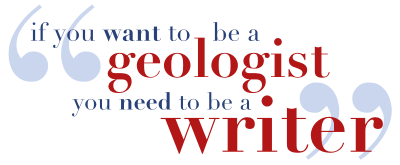Review: Communicating Rocks
/Communicating Rocks by Peter Copeland
Pearson Education, July 2011, 160 pages

I heard about this new book for geo-writers at the SEG Annual Meeting. I was there to teach a one-day course on technical writing for geoscientists, so naturally I ordered the book immediately. I've been leafing through it for about a month now and here's my verdict: I quite like it. Too wishy-washy? OK, I really like the contents. I really don't like the physical book. At all.
Why so bristly? Full disclosure: I love books. I know my recto from my verso, so to speak. Seeing a book typeset in Times and Arial makes me sad. Witnessing a publisher using the world's cheapest paper, flimsiest cardstock, and laughable page layout, I start to wonder if it's true what they say about the end of days for the medium. When they go on to charge $38 for such a book, I know it's true what they say about academic publishers gouging their customers.
None of this is author Peter Copeland's fault, and of course none of it really changes the message he wants to convey: writing matters. More particularly, your writing matters. Reading this short book, squarely aimed at and tailored for academic geoscientists, will make a difference to your writing. That's why it's on our recommended reading list.
I think it's fair to say that Copeland, a professor at the University of Houston, holds rather traditional views about writing. The first chapter, Communication equals thinking, is essentially a good-natured, 4000-word rant about the importance of writing well. He quotes the relatively tolerant George Orwell and the slightly-less-tolerant Lynne Truss, but gets quite worked up about the difference between forbid and prohibit, and sand and sandstone. I'm all for rigour and precision, but I do think there are contexts in which we can afford to write more comfortably, without feeling like we are programming a computer when we write. And I worry that would-be writers find it intimidating.
The second section of Copeland's book, Written communication, is the nub. After a look at types of writing, focusing pointedly on academic papers, there is a 65-page A-to-Z covering all sorts of topics from technical words to ordinary ones, and from points of English grammar to special geologic and scientific issues. One of the best passages is on accuracy, precision and repeatability; I will certainly refer to this section again. The section is rounded off with a useful collection of how-not-to examples, with clear and pertinent commentary—another dog-ear.
Section three covers oral and poster presentations: more solid advice that, if taken, will lead the reader to be a fine presenter of observations, interpretations and ideas. But the advice is conventional and I do wonder if there's a missed opportunity to inspire, perhaps tacitly permit, the gifted communicator to take the risk of giving a remarkable presentation.
 The final part of the book, aptly entitled Writing is hard, is another short piece about the graft of writing. Copeland celebrates the sheer hard work of planning to write, grinding out the first draft, and then writing the words all over again to make them the ones you really wanted. All excellent, practical, realistic advice for the grad student especially.
The final part of the book, aptly entitled Writing is hard, is another short piece about the graft of writing. Copeland celebrates the sheer hard work of planning to write, grinding out the first draft, and then writing the words all over again to make them the ones you really wanted. All excellent, practical, realistic advice for the grad student especially.
Having accused Copeland of being a bit strict, I'll reveal myself to be a complete hypocrite by saying that I looked for several of my favourite peeves (i.e. and e.g., or the correct use of significant and begs the question) only to find them missing. And there is at least one slip: a billion is certainly no longer 10¹² in the UK. The 15 or so colour figures are generally quite weak, the math typesetting is poor, and the tables are grim. Stranger still, Copeland likes pie charts:
Pie charts are a fine way of displaying the relative amounts of several components.
Sacrilege! Or perhaps the very fact that all writing ranters have their own pet peeves means that they are nothing more than just peeves: silly predilections that don't really matter.








 Except where noted, this content is licensed
Except where noted, this content is licensed